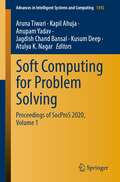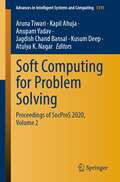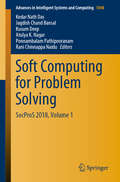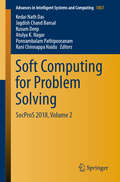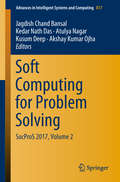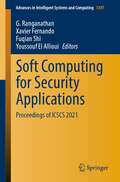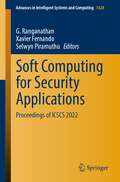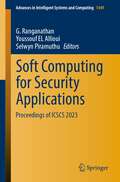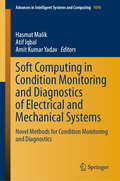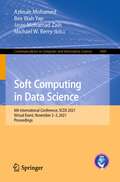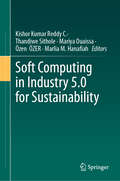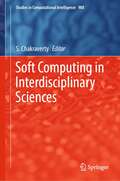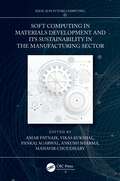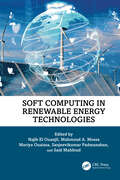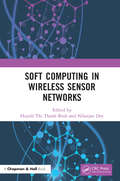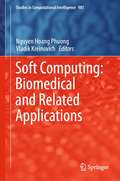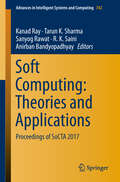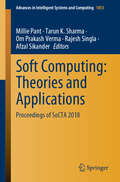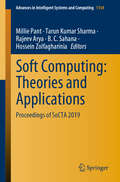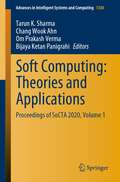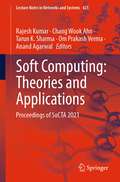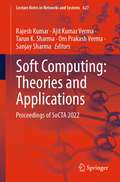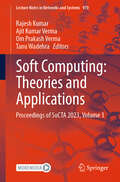- Table View
- List View
Soft Computing for Problem Solving: Proceedings of SocProS 2020, Volume 1 (Advances in Intelligent Systems and Computing #1392)
by Anupam Yadav Kusum Deep Jagdish Chand Bansal Atulya K. Nagar Aruna Tiwari Kapil AhujaThis two-volume book provides an insight into the 10th International Conference on Soft Computing for Problem Solving (SocProS 2020). This international conference is a joint technical collaboration of Soft Computing Research Society and Indian Institute of Technology Indore. The book presents the latest achievements and innovations in the interdisciplinary areas of soft computing. It brings together the researchers, engineers and practitioners to discuss thought-provoking developments and challenges, in order to select potential future directions. It covers original research papers in the areas including but not limited to algorithms (artificial immune system, artificial neural network, genetic algorithm, genetic programming and particle swarm optimization) and applications (control systems, data mining and clustering, finance, weather forecasting, game theory, business and forecasting applications). The book will be beneficial for young as well as experienced researchers dealing across complex and intricate real-world problems for which finding a solution by traditional methods is a difficult task.
Soft Computing for Problem Solving: Proceedings of SocProS 2020, Volume 2 (Advances in Intelligent Systems and Computing #1393)
by Anupam Yadav Kusum Deep Jagdish Chand Bansal Atulya K. Nagar Aruna Tiwari Kapil AhujaThis two-volume book provides an insight into the 10th International Conference on Soft Computing for Problem Solving (SocProS 2020). This international conference is a joint technical collaboration of Soft Computing Research Society and Indian Institute of Technology Indore. The book presents the latest achievements and innovations in the interdisciplinary areas of soft computing. It brings together the researchers, engineers and practitioners to discuss thought-provoking developments and challenges, in order to select potential future directions. It covers original research papers in the areas including but not limited to algorithms (artificial immune system, artificial neural network, genetic algorithm, genetic programming and particle swarm optimization) and applications (control systems, data mining and clustering, finance, weather forecasting, game theory, business and forecasting applications). The book will be beneficial for young as well as experienced researchers dealing across complex and intricate real-world problems for which finding a solution by traditional methods is a difficult task.
Soft Computing for Problem Solving: Proceedings of the SocProS 2022 (Lecture Notes in Networks and Systems #547)
by Millie Pant Kusum Deep Atulya K. Nagar Manoj Thakur Samar Agnihotri Bharat Singh RajpurohitThis book provides an insight into the 11th International Conference on Soft Computing for Problem Solving (SocProS 2022). This international conference is a joint technical collaboration of the Soft Computing Research Society and the Indian Institute of Technology Mandi. This book presents the latest achievements and innovations in the interdisciplinary areas of Soft Computing, Machine Learning, and Data Science. It brings together the researchers, engineers, and practitioners to discuss thought-provoking developments and challenges, in order to select potential future directions. It covers original research papers in the areas including but not limited to algorithms (artificial neural network, deep learning, statistical methods, genetic algorithm, and particle swarm optimization) and applications (data mining and clustering, computer vision, medical and healthcare, finance, data envelopment analysis, business, and forecasting applications). This book is beneficial for young as well as experienced researchers dealing across complex and intricate real-world problems for which finding a solution by traditional methods is a difficult task.
Soft Computing for Problem Solving: SocProS 2018, Volume 1 (Advances in Intelligent Systems and Computing #1048)
by Kedar Nath Das Kusum Deep Jagdish Chand Bansal Atulya K. Nagar Ponnambalam Pathipooranam Rani Chinnappa NaiduThis two-volume book presents the outcomes of the 8th International Conference on Soft Computing for Problem Solving, SocProS 2018. This conference was a joint technical collaboration between the Soft Computing Research Society, Liverpool Hope University (UK), and Vellore Institute of Technology (India), and brought together researchers, engineers and practitioners to discuss thought-provoking developments and challenges in order to select potential future directions. The book highlights the latest advances and innovations in the interdisciplinary areas of soft computing, including original research papers on algorithms (artificial immune systems, artificial neural networks, genetic algorithms, genetic programming, and particle swarm optimization) and applications (control systems, data mining and clustering, finance, weather forecasting, game theory, business and forecasting applications). It offers a valuable resource for both young and experienced researchers dealing with complex and intricate real-world problems that are difficult to solve using traditional methods.
Soft Computing for Problem Solving: SocProS 2018, Volume 2 (Advances in Intelligent Systems and Computing #1057)
by Kedar Nath Das Kusum Deep Jagdish Chand Bansal Atulya K. Nagar Ponnambalam Pathipooranam Rani Chinnappa NaiduThis two-volume book presents the outcomes of the 8th International Conference on Soft Computing for Problem Solving, SocProS 2018. This conference was a joint technical collaboration between the Soft Computing Research Society, Liverpool Hope University (UK), and Vellore Institute of Technology (India), and brought together researchers, engineers and practitioners to discuss thought-provoking developments and challenges in order to select potential future directions. The book highlights the latest advances and innovations in the interdisciplinary areas of soft computing, including original research papers on algorithms (artificial immune systems, artificial neural networks, genetic algorithms, genetic programming, and particle swarm optimization) and applications (control systems, data mining and clustering, finance, weather forecasting, game theory, business and forecasting applications). It offers a valuable resource for both young and experienced researchers dealing with complex and intricate real-world problems that are difficult to solve using traditional methods.
Soft Computing for Problem Solving: Socpros 2017, Volume 1 (Advances In Intelligent Systems and Computing #816)
by Kedar Nath Das Kusum Deep Jagdish Chand Bansal Atulya Nagar Akshay Kumar OjhaThis two-volume book presents outcomes of the 7th International Conference on Soft Computing for Problem Solving, SocProS 2017. This conference is a joint technical collaboration between the Soft Computing Research Society, Liverpool Hope University (UK), the Indian Institute of Technology Roorkee, the South Asian University New Delhi and the National Institute of Technology Silchar, and brings together researchers, engineers and practitioners to discuss thought-provoking developments and challenges in order to select potential future directions The book presents the latest advances and innovations in the interdisciplinary areas of soft computing, including original research papers in the areas including, but not limited to, algorithms (artificial immune systems, artificial neural networks, genetic algorithms, genetic programming, and particle swarm optimization) and applications (control systems, data mining and clustering, finance, weather forecasting, game theory, business and forecasting applications). It is a valuable resource for both young and experienced researchers dealing with complex and intricate real-world problems for which finding a solution by traditional methods is a difficult task.
Soft Computing for Security Applications: Proceedings of ICSCS 2021 (Advances in Intelligent Systems and Computing #1397)
by Xavier Fernando Fuqian Shi G. Ranganathan Youssouf El AlliouiThis book features selected papers from the International Conference on Soft Computing for Security Applications (ICSCS 2021), held at Dhirajlal Gandhi College of Technology, Tamil Nadu, India, during June 2021. It covers recent advances in the field of soft computing techniques such as fuzzy logic, neural network, support vector machines, evolutionary computation, machine learning and probabilistic reasoning to solve various real-time challenges. The book presents innovative work by leading academics, researchers, and experts from industry.
Soft Computing for Security Applications: Proceedings of ICSCS 2022 (Advances in Intelligent Systems and Computing #1428)
by Selwyn Piramuthu Xavier Fernando G. RanganathanThis book features selected papers from the International Conference on Soft Computing for Security Applications (ICSCS 2022), held at Dhirajlal Gandhi College of Technology, Tamil Nadu, India, during April 21–22, 2022. It covers recent advances in the field of soft computing techniques such as fuzzy logic, neural network, support vector machines, evolutionary computation, machine learning and probabilistic reasoning to solve various real-time challenges. This book presents innovative work by leading academics, researchers, and experts from industry.
Soft Computing for Security Applications: Proceedings of ICSCS 2023 (Advances in Intelligent Systems and Computing #1449)
by Selwyn Piramuthu G. Ranganathan Youssouf El AlliouiThis book features selected papers from the International Conference on Soft Computing for Security Applications (ICSCS 2023), held at Dhirajlal Gandhi College of Technology, Tamil Nadu, India, during April 21–22, 2023. It covers recent advances in the field of soft computing techniques such as fuzzy logic, neural network, support vector machines, evolutionary computation, machine learning, and probabilistic reasoning to solve various real-time challenges. The book presents innovative work by leading academics, researchers, and experts from industry.
Soft Computing in Condition Monitoring and Diagnostics of Electrical and Mechanical Systems: Novel Methods for Condition Monitoring and Diagnostics (Advances in Intelligent Systems and Computing #1096)
by Atif Iqbal Hasmat Malik Amit Kumar YadavThis book addresses a range of complex issues associated with condition monitoring (CM), fault diagnosis and detection (FDD) in smart buildings, wide area monitoring (WAM), wind energy conversion systems (WECSs), photovoltaic (PV) systems, structures, electrical systems, mechanical systems, smart grids, etc. The book’s goal is to develop and combine all advanced nonintrusive CMFD approaches on a common platform. To do so, it explores the main components of various systems used for CMFD purposes.The content is divided into three main parts, the first of which provides a brief introduction, before focusing on the state of the art and major research gaps in the area of CMFD. The second part covers the step-by-step implementation of novel soft computing applications in CMFD for electrical and mechanical systems. In the third and final part, the simulation codes for each chapter are included in an extensive appendix to support newcomers to the field.
Soft Computing in Data Science: 6th International Conference, SCDS 2021, Virtual Event, November 2–3, 2021, Proceedings (Communications in Computer and Information Science #1489)
by Michael W. Berry Bee Wah Yap Azlinah Mohamed Jasni Mohamad ZainThis book constitutes the refereed proceedings of the 6th International Conference on Soft Computing in Data Science, SCDS 2021, which was held virtually in November 2021. The 31 revised full papers presented were carefully reviewed and selected from 79 submissions. The papers are organized in topical sections on AI techniques and applications; data analytics and technologies; data mining and image processing; machine & statistical learning.
Soft Computing in Engineering
by Jamshid GhaboussiSoft computing methods such as neural networks and genetic algorithms draw on the problem solving strategies of the natural world which differ fundamentally from the mathematically-based computing methods normally used in engineering. Human brains are highly effective computers with capabilities far beyond those of the most sophisticated electronic computers. The 'soft computing‘ methods they use can solve very difficult inverse problems based on reduction in disorder. This book outlines these methods and applies them to a range of difficult engineering problems, including applications in computational mechanics, earthquake engineering, and engineering design. Most of these are difficult inverse problems – especially in engineering design – and are treated in depth.
Soft Computing in Industry 5.0 for Sustainability
by Mariya Ouaissa Kishor Kumar Reddy C. Thandiwe Sithole Özen Özer Marlia M. HanafiahSoft computing and Industry 5.0 are two distinct concepts that, when combined, can have a significant impact on sustainability initiatives within various industries. Soft computing is a subfield of artificial intelligence (AI) that aims to address problems characterized by uncertainty, imprecision, and partial truth. It encompasses various computational techniques, such as fuzzy logic, neural networks, genetic algorithms, and machine learning, which enable machines to deal with complex and uncertain data in a more human-like manner. Soft computing techniques are particularly valuable in sustainability efforts because they can handle non-linear relationships and uncertain data that often arise in environmental and social contexts. For example, they can be used to optimize energy consumption, waste management, and resource allocation in industries by considering various factors and trade-offs. The book highlights the latest innovations in intelligent systems in classical machine learning, deep learning, Internet of Things (IoT), Industrial Internet of Things (IIoT), blockchain, knowledge representation, knowledge management, big data, and natural language processing. (NLP). The book contains many contemporary articles from both scientists and practitioners working in many fields where soft computing, intelligent systems and the IIoT can break new ground. Intelligent systems and the Internet of Things are now essential technologies in almost every field. From agriculture to industry to healthcare, the scope of smart systems and IIoT is as wide as the horizon. Nowadays, these technologies are extensively used in developed countries, but they are still at an early stage in emerging countries. The primary market of this book is senior undergraduate students, post graduate students, practitioners, researchers, academicians, industrialists, and professionals working in areas of core computer science, electrical engineering, mechanical engineering, environmental engineering and agricultural engineering. The secondary audience of this book is individuals working in the areas of manufacturing, agriculture, remote sensing, environmental engineering, health care, smart cities, smart farming, remote sensing, supply chain management and hydrology.
Soft Computing in Interdisciplinary Sciences (Studies in Computational Intelligence #988)
by S. ChakravertyThis book meets the present and future needs for the interaction between various science and technology/engineering areas on the one hand and different branches of soft computing on the other. Soft computing is the recent development about the computing methods which include fuzzy set theory/logic, evolutionary computation (EC), probabilistic reasoning, artificial neural networks, machine learning, expert systems, etc. Soft computing refers to a partnership of computational techniques in computer science, artificial intelligence, machine learning, and some other engineering disciplines, which attempt to study, model, and analyze complex problems from different interdisciplinary problems. This, as opposed to traditional computing, deals with approximate models and gives solutions to complex real-life problems. Unlike hard computing, soft computing is tolerant of imprecision, uncertainty, partial truth, and approximations. Interdisciplinary sciences include various challenging problems of science and engineering. Recent developments in soft computing are the bridge to handle different interdisciplinary science and engineering problems. In recent years, the correspondingly increased dialog between these disciplines has led to this new book. This is done, firstly, by encouraging the ways that soft computing may be applied in traditional areas, as well as point towards new and innovative areas of applications and secondly, by encouraging other scientific disciplines to engage in a dialog with the above computation algorithms outlining their problems to both access new methods as well as to suggest innovative developments within itself.
Soft Computing in Materials Development and its Sustainability in the Manufacturing Sector (Edge AI in Future Computing)
by Amar Patnaik Vikas Kukshal Pankaj Agarwal Ankush Sharma Mahavir ChoudharyThis book focuses on the application of soft computing in materials and manufacturing sectors with the objective to offer an intelligent approach to improve the manufacturing process, material selection and characterization techniques for developing advanced new materials. It unveils different models and soft computing techniques applicable in the field of advanced materials and solves the problems to help the industry and scientists to develop sustainable materials for all purposes. The book focuses on the overall well-being of the environment for better sustenance and livelihood. Firstly, the authors discuss the implementation of soft computing in the various areas of engineering materials. They also review the latest intelligent technologies and algorithms related to the state-of-the-art methodologies of monitoring and effective implementation of sustainable engineering practices. Finally the authors examine the future generation of sustainable and intelligent monitoring techniques beneficial for manufacturing, and cover novel soft computing techniques for the purpose of effective manufacturing processes at par with the standards laid down by the International Standards of Organization (ISO). This book is intended for academics and researchers from all the fields of engineering interested in joining interdisciplinary initiatives on soft computing techniques for advanced materials and manufacturing.
Soft Computing in Renewable Energy Technologies (Advances in Digital Technologies for Smart Applications)
by Sanjeevikumar Padmanaban Mariya Ouaissa Mahmoud A. Mossa Najib El Ouanjli Said MahfoudThis book addresses and disseminates state-of-the-art research and development in the applications of soft computing techniques for renewable energy systems. It covers topics such as solar energy, wind energy, and solar concentrator technologies, as well as building systems and power generation systems. In all these areas, applications of soft computing methods such as artificial neural networks, genetic algorithms, particle swarm optimization, cuckoo search, fuzzy logic, and a combination of these, called hybrid systems, are included. This book is a source for students interested in the fields of renewable energy and the application of the soft computing. In addition, our book can be considered as a reference for researchers and academics since it will include applications of soft computing in different renewable energy systems.
Soft Computing in Wireless Sensor Networks
by Nilanjan Dey Huynh Thi Thanh BinhThis book focuses on the suitable methods to solve optimization problems in wireless network system utilizing digital sensors like Wireless Sensor Network. This kind of system has been emerging as the cornerstone technology for all new smart devices and its direct application in many fields in life.
Soft Computing: Biomedical and Related Applications (Studies in Computational Intelligence #981)
by Vladik Kreinovich Nguyen Hoang PhuongThis book lists current and potential biomedical uses of computational intelligence methods. These methods are used in diagnostics and treatment of such diseases as cancer, cardiac diseases, pneumonia, stroke, and COVID-19. Many biomedical problems are difficult; so, often, the current methods are not sufficient, new methods need to be developed. To confidently apply the new methods to critical life-and-death medical situations, it is important to first test these methods on less critical applications. The book describes several such promising new methods that have been tested on problems from agriculture, computer networks, economics and business, pavement engineering, politics, quantum computing, robotics, etc. This book helps practitioners and researchers to learn more about computational intelligence methods and their biomedical applications—and to further develop this important research direction.
Soft Computing: Proceedings of SoCTA 2017 (Advances in Intelligent Systems and Computing #742)
by Kanad Ray Tarun K. Sharma Sanyog Rawat Anirban Bandyopadhyay R. K. SainiThe book focuses on soft computing and its applications to solve real-world problems occurring in different domains ranging from medicine and healthcare, and supply chain management to image processing and cryptanalysis. It includes high-quality papers presented in the International Conference on Soft Computing: Theories and Applications (SoCTA 2017), organized by Bundelkhand University, Jhansi, India. Offering significant insights into soft computing for teachers and researchers alike, the book inspires more researchers to work in the field of soft computing.
Soft Computing: Proceedings of SoCTA 2018 (Advances in Intelligent Systems and Computing #1053)
by Millie Pant Tarun K. Sharma Om Prakash Verma Rajesh Singla Afzal SikanderThe book focuses on soft computing and its applications to solve real-world problems in different domains, ranging from medicine and health care, to supply chain management, image processing and cryptanalysis. It includes high-quality papers presented at the International Conference on Soft Computing: Theories and Applications (SoCTA 2018), organized by Dr. B. R. Ambedkar National Institute of Technology, Jalandhar, Punjab, India. Offering significant insights into soft computing for teachers and researchers alike, the book inspires more researchers to work in the field of soft computing.
Soft Computing: Proceedings of SoCTA 2019 (Advances in Intelligent Systems and Computing #1154)
by Millie Pant Tarun Kumar Sharma Rajeev Arya B. C. Sahana Hossein ZolfaghariniaThis book focuses on soft computing and how it can be applied to solve real-world problems arising in various domains, ranging from medicine and healthcare, to supply chain management, image processing and cryptanalysis. It gathers high-quality papers presented at the International Conference on Soft Computing: Theories and Applications (SoCTA 2019), organized by the National Institute of Technology Patna, India. Offering valuable insights into soft computing for teachers and researchers alike, the book will inspire further research in this dynamic field.
Soft Computing: Proceedings of SoCTA 2020, Volume 1 (Advances in Intelligent Systems and Computing #1380)
by Bijaya Ketan Panigrahi Tarun K. Sharma Om Prakash Verma Chang Wook AhnThis book focuses on soft computing and how it can be applied to solve real-world problems arising in various domains, ranging from medicine and healthcare, to supply chain management, image processing and cryptanalysis. It gathers high-quality papers presented at the International Conference on Soft Computing: Theories and Applications (SoCTA 2020), organized online. The book is divided into two volumes and offers valuable insights into soft computing for teachers and researchers alike; the book will inspire further research in this dynamic field.
Soft Computing: Proceedings of SoCTA 2021 (Lecture Notes in Networks and Systems #425)
by Rajesh Kumar Tarun K. Sharma Om Prakash Verma Chang Wook Ahn Anand AgarwalThis book focuses on soft computing and how it can be applied to solve real-world problems arising in various domains, ranging from medicine and healthcare, to supply chain management, image processing, and cryptanalysis. It gathers high-quality papers presented at the International Conference on Soft Computing: Theories and Applications (SoCTA 2021), organized online. The book offers valuable insights into soft computing for teachers and researchers alike; the book will inspire further research in this dynamic field.
Soft Computing: Proceedings of SoCTA 2022 (Lecture Notes in Networks and Systems #627)
by Ajit Kumar Verma Sanjay Sharma Rajesh Kumar Tarun K. Sharma Om Prakash VermaThis book focuses on soft computing and how it can be applied to solve real-world problems arising in various domains, ranging from medicine and health care, to supply chain management, image processing and cryptanalysis. It gathers high-quality papers presented at the International Conference on Soft Computing: Theories and Applications (SoCTA 2022), held at University Institute of Technology, Himachal Pradesh University Shimla, Himachal Pradesh, India. The book offers valuable insights into soft computing for teachers and researchers alike; the book inspires further research in this dynamic field.
Soft Computing: Proceedings of SoCTA 2023, Volume 1 (Lecture Notes in Networks and Systems #970)
by Ajit Kumar Verma Rajesh Kumar Om Prakash Verma Tanu WadehraThis book focuses on soft computing and how it can be applied to solve real-world problems arising in various domains, ranging from medicine and healthcare, to supply chain management, image processing, and cryptanalysis. It gathers high-quality papers presented at the International Conference on Soft Computing: Theories and Applications (SoCTA 2023), held at Indian Institute of Information Technology (IIIT) Una, Himachal Pradesh, India, during 21–23 December 2023. The book offers valuable insights into soft computing for teachers and researchers alike; the book inspires further research in this dynamic field.
